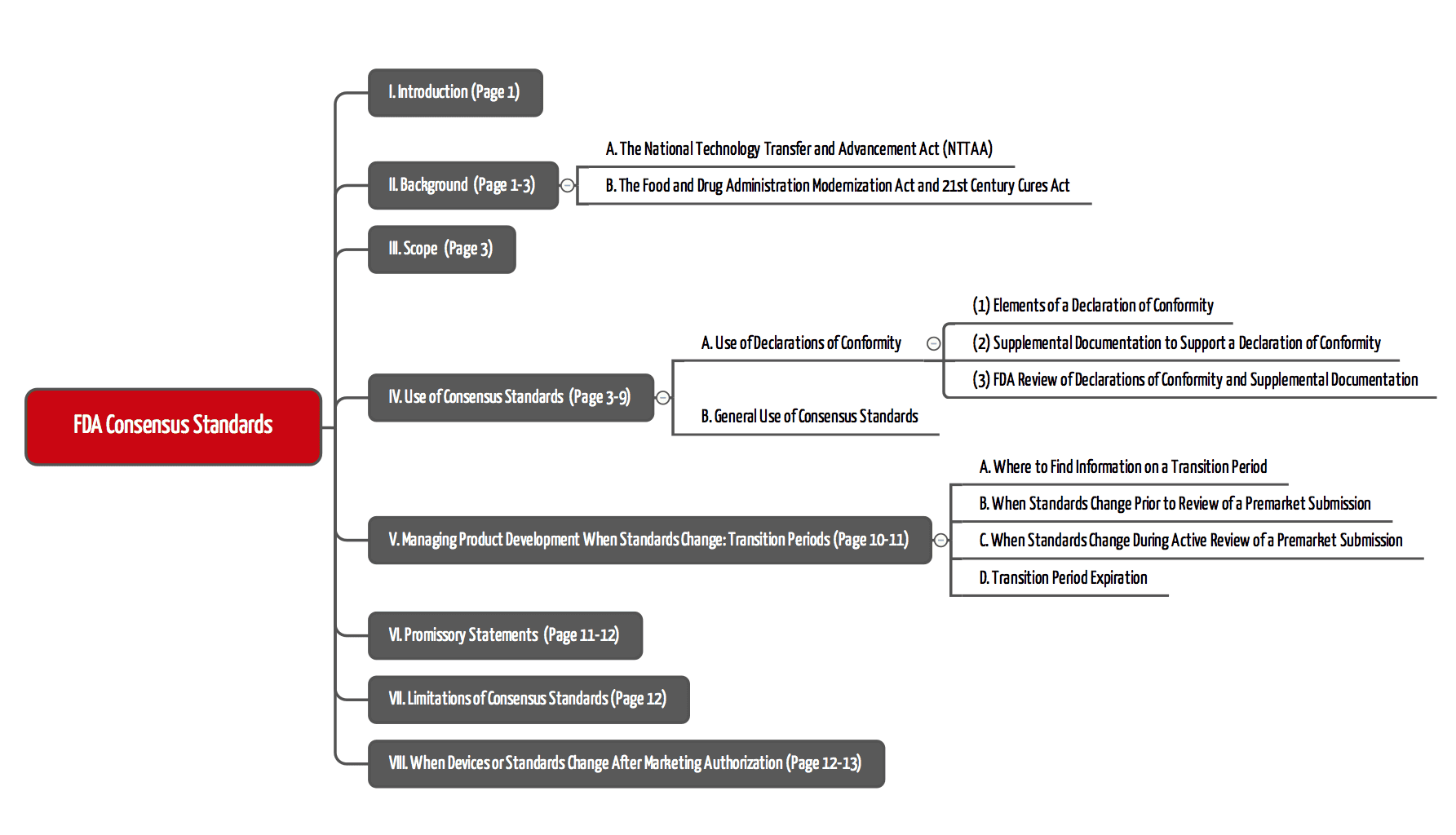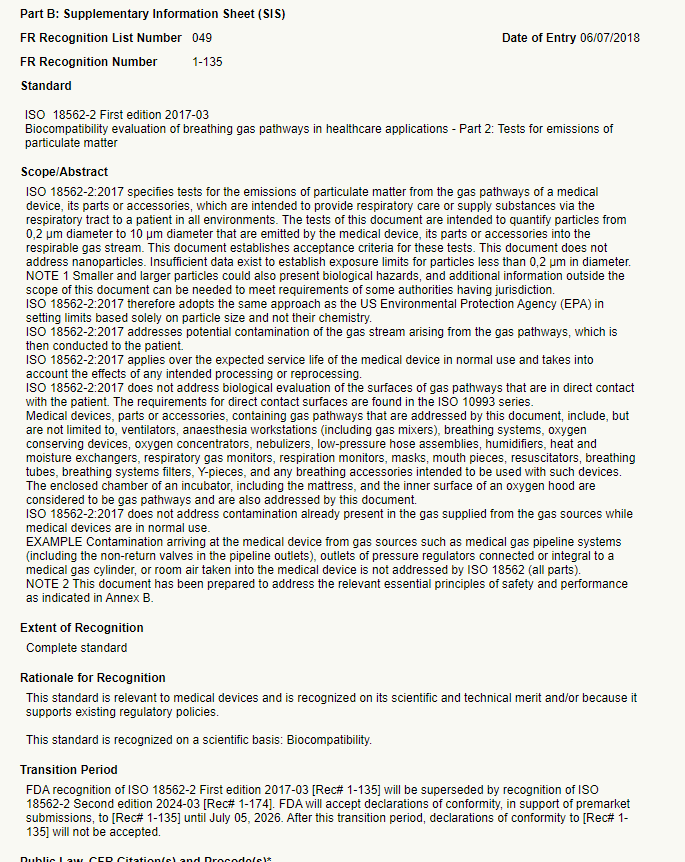The FDA offers manufacturers the opportunity to use so-called recognized consensus standards for the approval of their devices.
The US authority has published a “guidance” document on these consensus standards, presented in this article.
It also describes the requirements for using the standards and the advantages for manufacturers, but also points out typical mistakes.
You can find this guidance document, “Appropriate Use of Voluntary Consensus Standards in Premarket Submissions for Medical Devices,” on the FDA website.

Consensus standards: An overview
1. Consensus standards are (almost) always voluntary
Medical device manufacturers can but do not have to use these standards. This optionality applies with a few exceptions: Some laws contain an “incorporation by reference,” such as 21 CFR part 830.10, which requires specific standards for coding the UDI.
2. Conformity with consensus standards is not enough
Manufacturers may declare conformity with standards themselves in the form of a Declaration of Conformity (DoC). However, the FDA clarifies that this conformity is not necessarily sufficient for approval.
This is comparable to the harmonized standards for EU directives. Annexes Z of these standards specify which directive requirements have been demonstrated to be compliant with the standard, which have been partially demonstrated, and which have not been demonstrated at all.
3. Examples
Examples of these recognized consensus standards are the following standards
- ISO 14971
- IEC 60601-1 and IEC 60601-1-2
- IEC 62304
- UL 2900-1 and UL 2900-2-1
The FDA has published all “standards” in a database.
4. 514(c) forms the legal framework
The regulatory basis is provided by the Food, Drug & Cosmetic Act in Section 514(c). This stipulates that the FDA
“shall, by publication in the Federal Register […] recognize all or part of an appropriate standard established by a nationally or internationally recognized standard development organization for which a person may submit a declaration of conformity in order to meet a premarket submission requirement or other requirement […].”
The FDA also explains what is meant by “recognize”:
“The term “recognize” in section 514(c) of the FD&C Act refers to FDA’s formal identification of a standard after a determination that it is appropriate for manufacturers of products to declare conformance to meet relevant requirements in the FD&C Act, including premarket submission requirements.“
Advantages of consensus standards for manufacturers
1. Faster approval
The FDA indicates that approval can be granted more quickly if manufacturers follow the recognized consensus standards:
“When used appropriately, consensus standards will typically reduce the amount of documentation that a submitter needs to provide and may reduce FDA review time.“
2. Submitting less documentation
The declaration of conformity often saves manufacturers from having to submit the complete documentation. However, the FDA clarifies that many standards are too general to provide sufficient proof. It cites ISO 14971 as an example.
In these cases, the authority does request further documentation, such as test reports. Usually, only if the standard defines clear test specifications and acceptance criteria, FDA does not request full test reports or supplemental data. Even IEC 60601-1 only partially includes such specifications and acceptance criteria.
| Test method defined | Acceptance criteria defined | Submit complete test report? |
| yes | no | no, but summary |
| no | yes | no, but supplemental documentation |
| yes | yes | no |
| no | no | yes |
3. Usable for all approval procedures
Manufacturers may use these consensus standards in all approval procedures, such as
- Classic Premarket Notification (PMN) according to 510(k)
- Special forms of the 510(k) such as the “abbreviated 510(k)” or the “special 510(k)”
- De Novo request
- Investigational Device Exemption (IDE) application
- Premarket Approval (PMA) application
- Humanitarian Device Exemption (HDE) application
Typical mistakes made by manufacturers
1. Using incorrect versions of the consensus standards
In its “Recognized Consensus Database,” the FDA publishes the standards in the respective versions that it recognizes.
These versions are not always the latest available versions of the standards. For example, ISO 18562-2 is currently recognized in the 2017 as well as the 2024 edition. However, the 2017 version can only be applied in premarket submissions until July 5, 2025 (see Fig. 2).

2. Overlooking the fact that the standard is not recognized or that only parts of the standard are recognized
The FDA reserves the right to recognize only parts of the standard. The database provides information on this. In the case of ISO 18562-2, this is the entire standard (see Fig. 2). However, the ISO 18562-1 is only partially recognized.
Manufacturers should also ensure that their device is within the scope of the respective standard.
The FDA also distinguishes between consensus standards and recognized consensus standards. Only the latter are published in its database, and only manufacturers may submit a declaration of conformity for the latter. This must also contain the “recognition number” of the respective standard.
3. Manufacturer does not fulfill the entire standard
The FDA expects full conformity if the manufacturer declares conformity with a consensus standard. The FDA emphasizes that an unjustified declaration of conformity will be considered falsified and penalized.
4. Manufacturer does not provide sufficient proof of conformity
Appropriate testing or verification must prove this conformity. The manufacturers must submit the corresponding test results (see above). The FDA insists that manufacturers carry out the inspections with the final device (“finished device”).
As in many cases, the FDA offers to consult with them, e.g., in the form of a pre-submission meeting.
Read more about pre-submission meetings here.
Transitional periods
1. FDA declares version of a standard invalid
The FDA checks that the recognized consensus standards are updated approximately twice a year. It regularly replaces old versions of the standards with new ones. The authority then usually allows manufacturers transitional periods. For example, there is such a transitional period in for the ISO 18562-2 in its 2017 edition:
“FDA recognition of ISO 18562-2 First edition 2017-03 [Rec# 1-135] will be superseded by recognition of ISO 18562-2 Second edition 2024-03 [Rec# 1-174]. FDA will accept declarations of conformity, in support of premarket submissions, to [Rec# 1-135] until July 05, 2026. After this transition period, declarations of conformity to [Rec# 1-135] will not be accepted.“
If the FDA recognizes a newer edition of a standard after market approval, the FDA does not expect a resubmission. The Declaration of Conformity (DoC) remains valid. However, new devices in a 510(k) procedure cannot refer to that device with its DoC. These new devices must comply with the current version.
2. Manufacturer wants to use a newer version of a standard than the one currently in force
If manufacturers wish to use a newer standard version, the FDA recommends contacting them and explaining the differences.
Speaking of which, it is open to anyone to propose a new standard to the FDA. You can find out more about this on the FDA’s website.
Conclusion
The recognized consensus standards regularly help manufacturers simplify and speed up the approval process in the USA. However, compliance with these standards can also be tricky:
On the one hand, as in the case of IEC 62304, the FDA checks conformity in addition to its own specifications. In the case of software, for example, it checks conformity with the requirements of the Software Validation Guidance Document.
On the other hand, manufacturers can only declare parts of the requirements as fulfilled.
If manufacturers are planning approval in countries other than the USA, there is usually no alternative to conformity with the standards – in Europe the harmonized standards.


